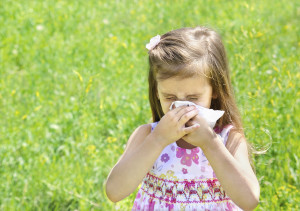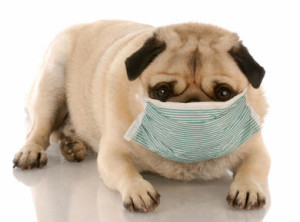 If your dog is scratching for long periods of time, or licking and biting his skin over and over, it is likely that he has an allergy of some kind. If your dog only seems to be bothered certain times of the year, your dog could have seasonal allergies. However, if your dog is itching, biting, licking, sneezing and coughing all during the year, it could be something other than seasonal allergies.
If your dog is scratching for long periods of time, or licking and biting his skin over and over, it is likely that he has an allergy of some kind. If your dog only seems to be bothered certain times of the year, your dog could have seasonal allergies. However, if your dog is itching, biting, licking, sneezing and coughing all during the year, it could be something other than seasonal allergies.
Just like with people, there are specific reasons your dog would have allergy symptoms all year round. One possible cause for your dog’s discomfort could be his food. Dog allergies to food isn’t all that common, but about 15 percent of dogs do have allergies to certain proteins in food, such as gluten and soy. If your dog is allergic to his food, the allergy might be due to soy protein, because more dogs are allergic to soy than gluten. Change your dog’s food to a non-soy formula for a period of 6 weeks and see if your dog’s allergy symptoms go away. Before changing your dog’s diet, you should consult with a veterinarian.
 Mold is another allergen that could be in your dog’s food. Many types of dog foods contain peanut shells, wheat and corn. Mold can grow on these substances in dog food, and when your dog ingests it, can have a systemic reaction, which causes him to itch. The molds can create mycotoxins within the body, which causes your dog’s immune system to be compromised. If your dog’s immune system is suppressed due to ingesting mold, he could have a severe itching problem. If your dog’s allergy symptoms go away, then it is very likely that your dog’s allergy was related to his food. To help prevent mold and other contaminants from getting into your dog’s food, you should store your dog’s food into an air tight container.
Mold is another allergen that could be in your dog’s food. Many types of dog foods contain peanut shells, wheat and corn. Mold can grow on these substances in dog food, and when your dog ingests it, can have a systemic reaction, which causes him to itch. The molds can create mycotoxins within the body, which causes your dog’s immune system to be compromised. If your dog’s immune system is suppressed due to ingesting mold, he could have a severe itching problem. If your dog’s allergy symptoms go away, then it is very likely that your dog’s allergy was related to his food. To help prevent mold and other contaminants from getting into your dog’s food, you should store your dog’s food into an air tight container.
Mold spores in the air of your home could be the problem, especially if your home is warm and humid. Bathrooms are the most common place to find mold, because this is the dampest room in the home. Your bathroom should have a ventilating fan, but if it doesn’t, you should keep a bathroom window open slightly to let the moisture out. You can have a problem with mold growing in the home any place where it is moist. Thus, if you live in an area where water doesn’t drain away very well, you are likely to have a problem with mold growing there. It’s important that you try to keep your home as dry as possible. If you have leaking drains under your sinks, it is imperative that you fix them to stop mold from growing. The mold spores in the air could be causing your dog’s allergies.
 If your home is in a flood zone, and your home has been flooded before, you are likely to have a mold growing problem. The type of mold that grows after a flood is black mold, which is different from the more common, Pennicillium mold. Black mold is highly toxic, and can make you very sick. This strain of mold is called Stachybotros;this kind of mold can make you and your dog very sick. It’s important that you get up the mold. You can call in professionals, or you can do it yourself. Make a solution of 1 part bleach and 10 parts water, and pour the mixture into a spray bottle. Spray the bleach solution onto the mold and let it sit for about 10 to 15 minutes and then clean up the mold. Be sure to wear disposable gloves, and use disposable cleaning materials, so that you will not cause recontamination of your home.
If your home is in a flood zone, and your home has been flooded before, you are likely to have a mold growing problem. The type of mold that grows after a flood is black mold, which is different from the more common, Pennicillium mold. Black mold is highly toxic, and can make you very sick. This strain of mold is called Stachybotros;this kind of mold can make you and your dog very sick. It’s important that you get up the mold. You can call in professionals, or you can do it yourself. Make a solution of 1 part bleach and 10 parts water, and pour the mixture into a spray bottle. Spray the bleach solution onto the mold and let it sit for about 10 to 15 minutes and then clean up the mold. Be sure to wear disposable gloves, and use disposable cleaning materials, so that you will not cause recontamination of your home.
Another possible cause of your dog’s allergy is another pet in the home. If you have a cat in the home, your dog could be allergic to cat dander. Male cats tend to leave more pet dander in the air than female cats. If you have a male cat, or a long haired cat, your dog could be sensitive to the dander that cat is producing.
It is a good idea to keep your vet informed of your dog’s allergies, and ask for suggestions of what to do to help your dog feel better. In the mean time, get a good air purifier with a HEPA filter. The HEPA filter catches mold, dust mites, animal dander out of the air. You should also vacuum often, if you have carpets, and use a good vacuum with a HEPA filter. You should also use a dehumidifier, if you have a mold problem in your home. Purifying the air in your home may be all you need to do to help your dog feel better.
Related Articles
